#artistic analysis
Explore tagged Tumblr posts
Text
The portraits of Neha and Elizabeth Beaufort: an analysis
By me



At first glance it was easy to observe the clear inspiration Neha’s portrait had of “the girl with the pearl earring”, however we can somehow feel this when looking at Beaufort’s portrait.
But the deeper we look into their character, the more we realise how opposed they are to each other, representing her inner character.
our first encounters
In both cases, you don’t know them for who they are, but you are introduced by what they are, “the novelty dice maker” and “the gardener”.
You get to later know their names, you might only know one for Neha but it doesn’t distance you from her, quite the opposite it feels like a nickname.
Learning Elizabeth Beaufort’s full name distances you from her, she is now a title, a figure of authority.
Neha is hidden, and if you wish you can even decide to go the whole game without seeing or talking to her. But Beaufort? She is centric to the story, you have to talk to her, she is one of the first characters you see when you go outside, one of the first that helps you in the examination process with the ammonia and gardening gloves.
the girl with the pearl earring
while we can see it clearly for Neha, it feels more vague for Elizabeth.
Neha’s head covering is worn in a more modest and classical manner, her pose practically identical to the reference, she symbolizes the “old” what was once. An art piece and aspiring individual of her time. The way her portrait is painted is very academic, there is very little use of dark outline if ever. Everything about it is almost soft and comforting.
In contrast Beaufort’s portrait adopts a widely different, almost provocative pose, the way she wears the headgear covering less for instance but attaching her hair, prioritizing practicality over appearances. There is a more modern touch to her portrait, the colours are saturated and there is a bold dark outline, she is defying the traditional. She represents the “youth” of Martinaise.
While Neha resembles almost identically to the portrait, Beaufort distances herself from it, the past but still she finds a way to keep a part of it, what made her what she is, and then turn it into something personal.
In both of their portraits, the background is applied similarly for the taints and almost like they were mirrored vertically, however Neha’s are softer, almost like they are fading away, while Beaufort’s are high in contrast.
the postures
The novelty dice maker, upon your first meeting with her, is turned away from you, she’s working, she stills open herself to you, as she presents her arts and studio in an almost familiar way. You enter her domain of creation, you’re inside her soul. Maybe you could picture it sort of like a confessional, there is intimacy between the two of them and they won't necessarily need to face each other. She looks at you from the side, seemingly making you feel as though you were disturbing her, and yet she is not. But she stills look at you from above, this could be referring to the fact she was up, high in her workshop’s room while the crime scene was unfolding, not only this but she “disregarded” it when it was happening, as she had one of the best view on it, and yet stayed absorbed by her art.
On the other hand, Beaufort is facing forward all time, she’s observing your every move, she looks up at you, from beneath it is easier to see all (visual calculus check “gardening in march”, you point out the fact she is stationed at the best spot to keep tabs of people). She looks at you with an interrogative expression, she was expecting you to be here, to talk to her. She shields herself from you when she crosses her arms or when she hides her real identity from you at the start by going as “the gardener”, she makes you believe that you are someone above her, and you believe it. She is always in a public space, never once alone, she is either outside or in the Whirling-in-rags. There is no intimacy, if even a way to talk to her as “Elizabeth” instead she is “a member of the union”, this could also be reflected in her looking upward, as stated earlier, as she is in the middle of a hierarchy in the Union. Her purpose is to exonerate the Union of the presumed crime, “the Union fixer”. She is cleaning up the mess caused by the Union’s dogs. Even if there is a “box” reminding of a confessional where the Hardie boys stay, it is, not only a long process to get them to confess, she is the first to stop them when they open up, but you are also constantly observed by the public, not only her but the people at the Whirling.
Knowing this, Neha also found herself “shielded” by the entrance of her studio, though it served an entirely different purpose as it can always be opened. Beaufort wears different masks that you can’t take off as you talk to her, but rather break by any new dialogues you have surrounding the case, there is no way to get under her skin without making her reach a breaking point. They are facing opposite directions, Neha leaned toward the past, Beaufort toward the future, but they both look in your direction: the present.
No matter their difference, both of them wear blue clothes, this reflecting their social class, they're both born blue collars, even if Beaufort wears a white shirt, representing the purity of her youth and her future aspirations, she works for the union, the symbol of the working class, she represent them on a legal point of view, as a lawyer. Her jean strapped overall partially visible in her portrait also can remind of a tank top, or “débardeur”, which could be an echo to the organization she works closely with, the dockworkers union” or “débardeurs’ union”. Elizabth’s softer features in comparison to Neha’s sharper ones also amplifies this duality of “youth” vs the “old”.
the lightings
Beaufort’s portrait shows a significant amount of green on her forehead, associating blue and yellow, blue symbolizing intellectual skills and yellow motorics, this is her mindset. However the right side of her face is lit in dark red, which can be associated with physique skills, indicating her short temper she tries to hide. The fact it is cast on the right side of her face could imply that it is her “real” face, what is “right”. In her eyes and her nose you can also see a reflexion of light that Neha doesn’t have, echoing to her “ bright and hopeful” futur, the fact she is highly regarded by her peers, but also maybe her more emotive tendencies, not in a derogatory way, but more in a youthful ardor, defending her ideals.
For Neha, her yellow, we could even say gold lighting highlights what she is handling right now, her works, her art, that is what is important to her, she is what she creates, her face being cast in the shadow. This choice of colour for the light might be associated with motorics skills knowing she is a dicemaker. The light could also represent the future ahead, the change in the world, the “miracle – from the northwest”. She is averting her gaze from it. It is too late for her.
#disco elysium#de#analysis#artistic analysis#portrait study#elizabeth beaufort#Neha#the gardener#novelty dicemaker#short essay#maybe#I'm not sure if it can qualify as such but whatever#it was fun to make#i love disco elysium sm#the girl with the pearl earring#art#discoposting
235 notes
·
View notes
Text
I was thinking some more about that one reblog where I tried to analyze the concepts of "objective quality" and "personal enjoyment" in the context of the different Tron movies.
And my brain kept getting stuck on my claim, near the end, that some things seemed "forced" to me in Legacy, but nothing seemed "forced" to me in the original movie.
Which I realize may be a hard feeling to explain.
Because the things that feel "forced" to me in Legacy are such little tiny inconsequential things (mainly little details that are put in there just to call back to earlier parts, like Quorra saying that she's "a rescue" in reference to Sam saying that earlier about Marvin). They're things that throw me just slightly out of the story, because I have trouble parsing them as things the characters would actually do or say, rather than parsing them as things that I can see the scriptwriters sticking in there to fill a particular narrative purpose.
But they aren't big, structural problems. If you changed them or took them out, you'd still have a story of pretty much the same shape.
Whereas in the original '82 movie, there are what seem like HUGE gaps. Things that… may not be exactly plotholes, but they demand explanation that isn't explicitly there, and they require imagination from the viewer.
Like why does Dillinger have such a laughably stupid password, and IS that why Flynn broke in so easily? And why does the MCP hide the incriminating evidence instead of destroying it? (Was it only to save it for the blackmailing-Dillinger purpose that he mentioned later? And if so, what did he tell Dillinger the reason was, prior to that?) How does poor nervous Crom start acting so confident by the time he's pitted against Flynn? Why does sweet gentle Ram seem so gleeful about killing his Lightcycle opponent? Did Flynn actually even play any important role in their escape, since Tron was the one who made the hole in the wall? …And so on.
And I'm not saying there aren't things like that in Legacy, too! But to me they somehow feel more smoothed-over, like they don't stick out as noticeably.
Maybe it's my own bias. Or maybe it's just how aesthetically polished Legacy feels to me.
Anyway, I think the best way I can think to express it is just to go back to my "car vs painting" analogy…
So, in that post, I argued that I don't see any actual difference between saying "I enjoyed it" and saying "I think its quality was objectively good." …Even though I know there are things that people sometimes describe as "objectively good quality" in a work of art, even if they didn't personally enjoy it.
And I know that some of the "polished" feel of Legacy-- the smoothness of the special effects and cinematography, the neatness and symmetry of the plot-- would fall into that category of things.
And when I was trying to explain why I don't use the term "objective quality" for this kind of polish… I said that to me it feels like "comparing the aesthetics of a Ferrari to the aesthetics of a Dali painting," and that I like paintings better than cars, and I like how a painting can be chaotic, but a car has every part forced into serving a specific purpose in its structure.
And I think that's probably what I meant by parts of Legacy feeling "forced" in a way that doesn't appeal to me.
The way I imagine it is, suppose you're building a car. And some of the materials you've chosen aren't actually that well suited to fitting into the car you're trying to build. But you bend them a little, turn them around into weird positions, squeeze them in and make them fit.
And at the end you've still got a car, and it's pretty much the same shape you planned for it to be. And it's still clear to everyone that your intent was to build a car, and to build it in a pretty normal car shape. And you've succeeded at that... well enough that the position of the few weirdly-placed parts is a small nitpick that most people wouldn't care about.
But suppose you take all the same materials, and instead of trying to build a car, you build a big chaotic weird sculpture out of them.
Maybe you've planned out some aesthetic themes, arranging the parts in patterns of your own design-- maybe some of those patterns are even set up to call to mind the idea of a car, or something of a car's aesthetics. There's a design in what you've built-- it's just not quite as specifically clear WHAT the intent behind it is.
And if some of the materials you chose don't end up fitting your original plan, you have more leeway here. You can even set them up in a weird, jarring way that sticks out from the rest of your pattern-- and the beauty of it is, your audience is not immediately gonna say "You did that wrong."
They're going to try to interpret it. They're going to try and come up with an understanding of why you chose to make it look that way. Because it's not a car, and it doesn't HAVE to have a certain shape, and as an artist you get the benefit of the doubt that however you made it look is probably how you wanted to make it look, and you did it for a reason.
Hell-- even if you WERE building a car, and you decided to make some parts stick out in an obviously weird, jarring way-- even then, if it was an obvious enough choice, viewers might still begin by trying to think of possible reasons why you chose to do it like that, instead of just yelling at you that it doesn't fit.
But if you squeezed the not-fitting parts in as inconspicuously as you could, and tried to hide how they don't fit-- Well, then maybe most people won't notice it, and maybe most people will think your design is objectively better than others.
But those who do notice will probably interpret it as a covered-up mistake, not an artistic choice. (And honestly? the same goes for painting and sculpture, a lot of the time.)
And my point is not that one movie's better than the other. It's that neither one is, because "objectively better" isn't a thing.
Every design has people who like it, people for whom it brought joy into the world. And all the technical analysis of what makes something good or bad-- well, it might help explain the number of people who like or dislike a thing, but it won't do much to change how those people feel.
10 notes
·
View notes
Text
Honestly people who think there is only ever one “correct” way to interpret a piece of art are just missing out on so much. Like the curtains can be blue because she’s sad or because blue were the colors of the Revolution at the time or to show royalty or any other reason! If you see it. If you buy it. Then the meaning is there. Whether or not the author meant it to be. Something even beyond the author could’ve ever thought. That’s the magic! That’s art! Stop constraining yourself!
9 notes
·
View notes
Text


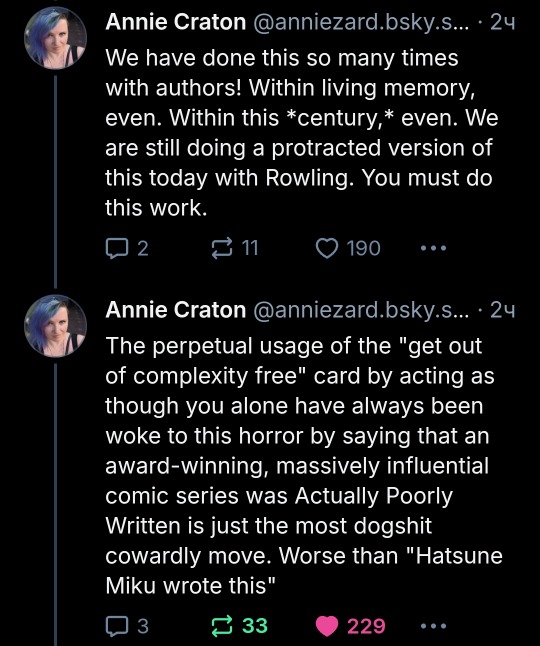
#she's right and she should say it#literature#comics#neil gaiman#neil gaiman allegations#good omens#the sandman#bluesky screenshot#media analysis#separating the art from the artist
45K notes
·
View notes
Text

Something you need to remember is that journalistic photographers are still artists at heart. When you are providing a source of information that is to be seen as "the truth" you are going to frame things to look a certain way.
You will publish the ones that look like what you want. The framing of Luigi Mangione's transportation is incredibly evocative of paintings of Jesus being arrested. It also (not so) coincidentally is often the framing of a hero being captured for the greater good.
This is ON PURPOSE. Do not discredit the artist by calling it a mistake. This was on purpose. The artist supports him and is framing him as a hero.
No matter how much corporate news may attempt to drown out the support for Mangione, artists always have the ear of the people. A picture is worth a thousand words, isn't it?
#politics#political#luigi mangione#current events#fuck ceos#anarchist#anarchism#anarchocommunism#anarchopunk#anarcho communism#all art is political#artists on tumblr#media analysis#social commentary#my commentary#opinion#analysis
4K notes
·
View notes
Text
#Seasons Through Art: Exploring #Spring's #Impressionism, #Summer's #Fauvism, #Autumn's #Romanticism, and #Winter's #Minimalism
#Art and #nature have always been intimately connected, with the changing seasons offering endless inspiration to artists throughout history. Each season, with its unique #colors, #light, and #atmosphere, can be paralleled to a distinct art movement, reflecting the mood and essence of these cyclical phases. Let’s embark on a journey through the seasons, exploring their connections to various art…

View On WordPress
#Abstract Interpretations#Aesthetic Trends#Agnes Martin#Art and Culture#Art and Emotion#Art and Environment#Art and Imagination#Art and Inspiration#Art and Nature#Art and Perception#Art Appreciation#Art Education#Art Exploration#Art History#Art Movements#Art Techniques#Artistic Analysis#Artistic Concepts#Artistic Creativity#Artistic Depth#Artistic Evolution#Artistic Experimentation#Artistic Exploration#Artistic Expressions#Artistic Influence#Artistic Inspiration#Artistic Interpretation#Artistic Journey#Artistic Legacy#Artistic Mastery
0 notes
Text







I hope y’all like greek mythology here…
Anyone else obsessed with EPIC??
#epic the musical#epic the wisdom saga#epic odysseus#odysseus#athena#greek mythology#the odyssey#fanart#digital art#artists on tumblr#illustration#character design#visdev#analysis#fantasy
5K notes
·
View notes
Text

Spy tf2 and his identity
Character analysis (or at least my vision on him, if you believe my reasoning)
What do we know about Spy? He's a disguise mastermind. He can pretend to be anyone in order to infiltrate into the scene to do his job - quite literally, stab people on the back. But when he's not in the battle, what is he to his teammates? A suave Frenchman, a gentleman with taste, somewhat a leader.
At least, that's the persona he prefers to show. But is he really..?
What if I tell you that this person never drops his disguise?
For a man who always wears a mask and who's identity being secret is a sacred part of his role in this job, isn't this persona too much to show if it is real? Frenchman, rich, ladykiller... Wouldn't it be too easy to decipher his identity with so much clues provided? Wouldn't it be dangerous?
While Miss Pauling and the Administrator definitely know Spy's real identity, hiding it is a major thing for whatever reason. One could assume it might be because of Scout (obvious guess) but I doubt he's a sole reason. Spy very much enjoys being the Spy all by himself. Do what's the deal?
Let's start from the beginning.
Why did Spy join Mann Co. in the first place?
Let's take this assumption as a fact: people come here out of desperation. They are professionals in their field, yet in their past/casual life there is a pattern of them having difficulties that push them into joining this service. I don't see why Spy would be an exception.
The reason for joining is usually money. Some people question why Spy, a wealthy man from higher society, would join Mann Co. if he has it all already.
Well, probably because he really does not.
Have you ever met an aristocrat? Wealthy people don't get so protective about their expensive suits, they can afford cleaning or a new one. Regardless, rich people don't usually get stingy about material goods, especially if they're mass produced.
At least, not those who were born into wealth.
Spy's defensiveness about his "wealthy stuff", his pomp-ness, disgust and arrogance towards "plebs" gives off a man who knows what it means to live in poverty and who doesn't want to be associated with it ever again.
(Not even talking about his own filthy habits such as not washing his mask and pissing on walls? Jesus Christ)
Dare I even guess that he might be not French at all? His French is so broken. (Although, so is Medic's German, but at least he uses his language much more frequently and in more complex sentences, while Spy only uses French to say some basic expressions, occasionally confusing them with other languages). Definitely not a native.
If anything, he's not giving "rich man" at all, he's giving con man. And that fits my picture perfectly.
So, poor upbringing. How old is Spy? If he's Scout's father (and he was young when he was conceived), I'd say he's no less than 20 years older than him. I'd give him a few more years actually. So, approximately Spy is around 50 at the events of the game (1968-1972). Let's assume he was born somewhere in the 1910s.
Even if he's not French, I still agree that he's probably European. Hmm, what was happening in Europe at the time Spy was a kid?
Oh yeah. The Great Depression.
See my picture: imagine, a child from a lower class family during the Great Depression, his parents were most likely to not take good care about him (both because of the economical situation AND as an echo to Spy's struggles with his own fatherhood). He has to run away from home early and start to make money. Any way possible.
Unavoidably, it leads to crime.
Petty theft, blackmail, scams. Changing identities. Selling low quality products and services. Changing identities again. When older, seducing rich women to stay at their homes overnight, be fed and supported. Running away from the police. Walking into a trap of the mafia, and then joining them as their goon.
In this nightmare of a life he just had to keep pretending to be someone else, someone better and stronger, in order to his ego to not completely shutter. He had to imagine he was an invincible mastermind trickster of some sort, not just a poor boo-hoo victim of poverty who has never knew normal life and care.
And if you pretend for long enough, you become your role eventually... Right?
His true self was long lost forgotten under many layers of new identities. Worse, his true self was never known. And he didn't want it to be known in its ugly and disgusting vulnerability. Narcissism became his lifeline.
It's so much better to be Spy. To be rich and elegant and respected. His ego rebuilt.
#tf2 spy#spy tf2#tf2#team fortress 2#artists on tumblr#my art#team fortress#tf2 theory#tf2 character analysis#character analysis#tf2 headcanons#npd queen we stan#tf2 fanart
1K notes
·
View notes
Text
Fundamentally, "The Owl House" is an allegorical story dealing with the dichotomy at the heart of the "American Dream", with Luz representing the ideal of America as a Melting Pot of Nations that brings together all the peoples of the world, while Belos/Philip represents the Manifest Destiny crap about how America exists to serve the interests of rich White Cishet Christian (preferably Protestant) Men and no one else. Both of them literally follow the classic American Immigrant Story™ of coming to a new land with nothing but the clothes on your back and making your way in the world with cleverness and ingenuity and intelligence. Luz even goes so far as to fall in love with the daughter of a prominent rich family and win her love in return like she’s in “Hamilton”. But whereas Belos attempts to destroy the Isles’ beautiful culture and/or twist to suit his own purposes so that he can kill and destroy everyone and everything on them, Luz accepts the culture of the Witches as her own and helps to restore it to its former glory after Belos is destroyed.
It’s also kind of a Christ allegory wherein Luz is a dark-skinned person raised by a working class single mother in a distant corner of the world’s most powerful nation who comes to a world straining under the weight of a truly terrible tyranny and helps people heal from their trauma and pain and love for her redeems or at least helps to redeem several flawed and broken people and her name can potentially even be taken as a reference to the messianic solar deity Sol Invictus and/or the Jewish concept of the Ur Ein Sof…oh, and her whole thing is descending into the Underworld and offering her life up to save its inhabitants and denizens.
(And no, I will not attempt to read Christian meanings into “Amphibia” or “The Ghost and Molly McGee”. “Amphibia” is a Buddhist story wherein the Calamity Trio (or at least Anne) are destined to transcend physical reality/Samsara and become deities/Bodhisatta through their good deeds and kindness, while Molly McGee is a personification of Tikkun Olam/a potential Tsadik Nistar who heals the world without realising just how much of a positive impact she’s been leaving on people, at least at first).
@disregardcanon @lady-asteria @witch-apologist @awakefor48hours @candyskiez
TOH Fans: OMG, you should watch The Owl House, there's gay witches that kiss on screen!!
Plot points about government corruption, ethnic cleansing, living with a chronic disability, white washed history, working through grief, having abusive parental figures, overcoming suicidal thoughts, and more

#The Owl House#The Owl House meta#Luz Noceda#Philip Wittebane#Emperor Belos#The Owl House spoilers#spoilers cw#chronic illness cw#image cw#politics cw#religious talk cw#mild religious talk cw#abuse cw#suicide mention cw#suicidal ideation cw#genocide mention cw#Jewish themes#Christian themes#artistic analysis
202 notes
·
View notes
Text
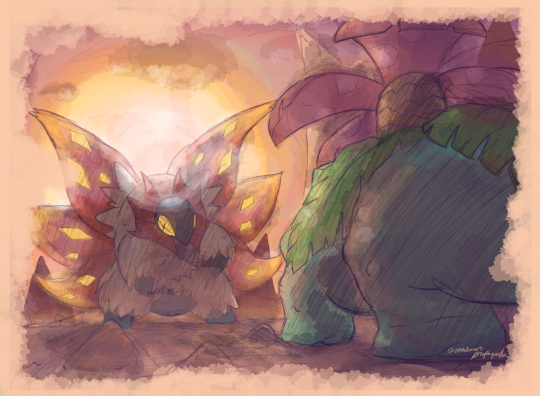
Drawing Venusaur with every Pokemon pt. Slither Wing
#***UPDATE*** Encounter with subject “Slither Wing” ended in a stalemate. Type analysis in progress...#*fig. 1* Partner Venusaur and Subject Slither Wing moments before battle#venusaur#slither wing#pokemon#paradox pokemon#pokemon scarlet and violet#fanart#artists on tumblr#digital painting#digital art#art challenge#🌺
1K notes
·
View notes
Text
"If an artist falls in love with you, you can never die."

#stranger things#mike wheeler#will byers#byler#mike x will#byler endgame#artists on tumblr#stranger things s5#stranger things season 4#byler thoughts#byler rain scene#byler flirting#byler canon#byler nation#byler tumblr#byler is canon#byler theory#byler fanart#byler fanfic#byler is real#byler analysis#byler brainrot#byler s5#st details#stranger things 5#stranger things theory#mike wheeler is not straight#will byers is in love with mike wheeler#mike wheeler is bi#mike wheeler angst
1K notes
·
View notes
Text





something something "Fiddleford’s innate domesticity comforting a man whose deepest desire was to come home" something something "a man who nurtures and cares for others to the point of heartbreak meeting a man who doesn’t remember what it’s like for anyone to care about him"
doodles very much inspired by @yujateaandpi's perfect and beautiful analysis of Fiddlestan
#i love these gay people#im not even kidding that was a perfect analysis#gay men with yellow eyes#fiddlestan#god theyre everything to me#fiddstan#young stan pines#young fiddleford#fiddleford hadron mcgucket#stanley pines#fiddleford mcgucket#gravity falls#my art#artists on tumblr
993 notes
·
View notes
Text
⚠️Spoilers for Look Back but I was initially confused about what Fujino and Kyomoto's relationship had to do with pursuing a career as a mangaka. After thinking about it, I interpret it as a narrative device to represent what will come when choosing to pursue art (of any form, whether it's comics, painting, animation, music, etc.).
Think about it, what's Kyomoto's role in the story? She is what got Fujino to take art seriously in middle school, and what motivated her to continue after she initially gave up. However, she's also the only thing in the story that makes Fujino wish she quit art. First, halfway through 6th grade and then later after her death. She serves as Fujino's motivator and de-motivator.
I think the scene of Fujino wishing that she never told Kyomoto to come out (that pursuing art only led to suffering) represents artists' regrets. We literally look back and see an alternate universe where Fujino never pursued art and it has a happier ending. Anyone that pursues artistic dreams will end up regretting it at some point. It's not easy, any artist will tell you that. The story is saying yes, you probably will end up healthier and more stable by giving up your dreams. Because art is suffering.
But then Fujino enters Kyomoto's room after reading the comic from the alternate reality and all of a sudden we get a montage of the happy memories and accomplishments they had pursuing their dreams together. And we realize that, everything we saw of them in the alternate 'happier' reality pales in comparison to this:


The happiest both of them look in that alternate world is when they finally meet and promise to work together someday. They loved art. They loved each other. Giving up on your dreams means missing out on all of that, and nothing in the world can replace it. Because yes art is suffering, but art is also joy and love.
And so the end of the story where Fujino goes back to work isn't her moving on. She tapes the comic strip in front of her to remind her of Kyomoto, to remind her of why she got into comics in the first place. Basically, Kyomoto IS art to Fujino. A life with her means experiencing both suffering and joy, while the life without her means having none of that.
I might be wrong about this, like maybe Fujimoto just wanted to tell a mangaka story with doomed yuri (valid) HOWEVER i like my interpretation so im sticking with it.
#sorry sorry sorry i just have Thoughts#and none of my friends have watched this movie so I dont have anyone to talk with about it#anyway this movie made me cry and gave me emotional damage. 10/10 highly recommend#i wanted to tag their shipname but i cant bc its literally just fujimoto's name why did he name them after himself im laughing#using a doomed love to represent artists' suffering and joy is genius btw#not everyone knows what its like to pursue art but everyone has that one person they loved (romantically or platonically) and lost#my post#Look Back#look back movie#look back spoilers#look back analysis#ayumu fujino#kyomoto
580 notes
·
View notes
Text


For the epic bird who managed to revive a fandom @randomalistic (<- SUCH A PASSIONATE AND KIND PERSON BTW YOU SHOULD TOTALLY GO WATCH THEIR VIDEO IF YOU HAVEN'T ALREADY! GO GO GO THIS IS AN ORDER!!!)

bonus doodles teehee, got attached to the idea of a little bird and its oxpecker-like relationship with the world's largest parasite :]c
#art#wreck it ralph#king candy#this guy has like 3 different names how do I tag this specific form?#ah whatever it's the bug#There's so much packed in that analysis I can't even put into proper words how good it is JUST GO WATCH IT!#ITS SO LOVINGLY MADE AND THEY GO IN DETAIL ABOUT THE ARTISTS AND THE BASTARD HIMSELF AND THE part where it talks about Vinny...#(GRITTING MY TEETH AND SOBBING) GOOD SHIT!!!#godspeed you silly bird <3
603 notes
·
View notes
Text
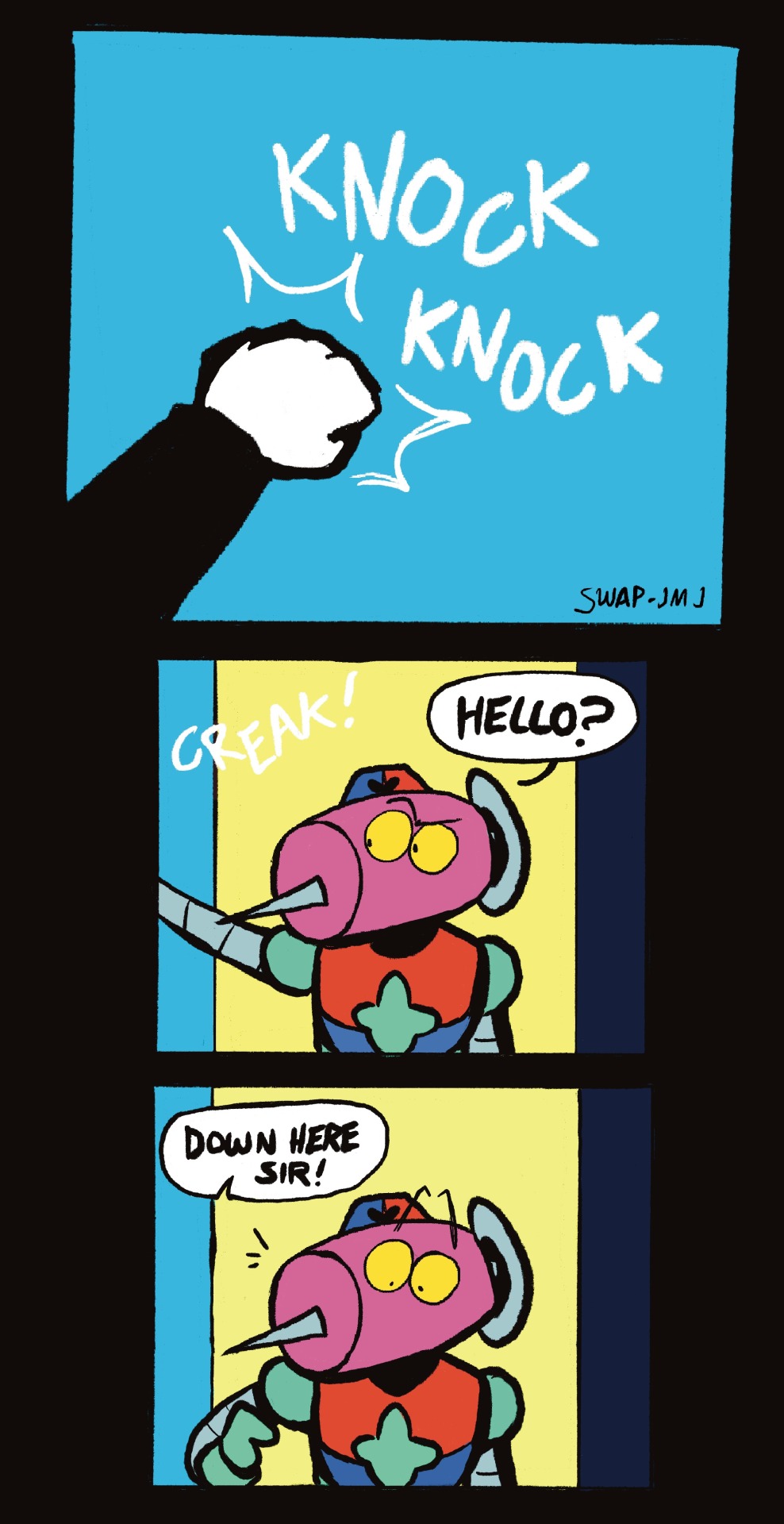

Another thing from a few months ago I finished up! hopefully the last Spamton related one lol (I love him but I wanna draw my ocs more honestly)
A lot of people like to think Addispam was a mailman, which is cool but I also think another interpretation could be that he was a door to door salesman. Think about it, Kris finds the other Addisons at specific shop locations, sort of like how you find ads on a website. But SPAM emails are sent directly to your email, kind of like how a door to door salesman comes to you to advertise their products!
I also think it fits because like spam emails, most people don’t like door to door salesmen. But yeah that’s my idea I guess
#my art#artists on tumblr#character analysis#<- ???#headcannons#spamton#artblr#fanart#comic#christian artist#webcomic#for some reason the colors were dulled down and I couldn’t make them look brighter#i had to copy and paste the images into another canvas and saturate them that way#weird..#addispam
257 notes
·
View notes
Text
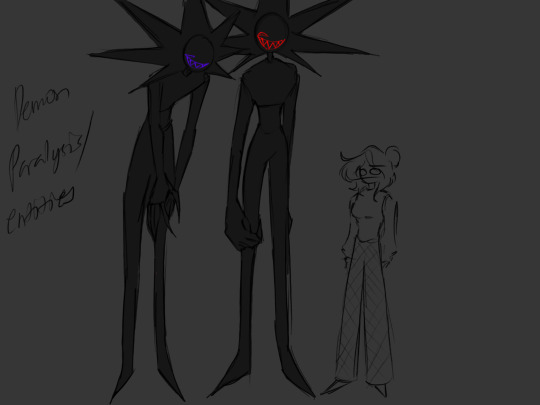
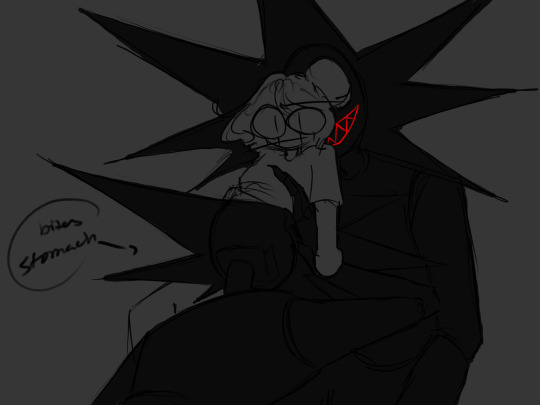
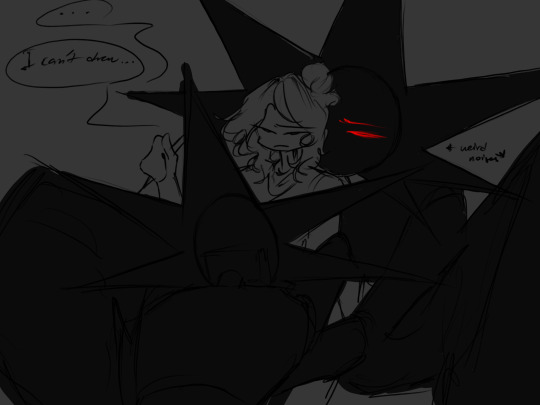
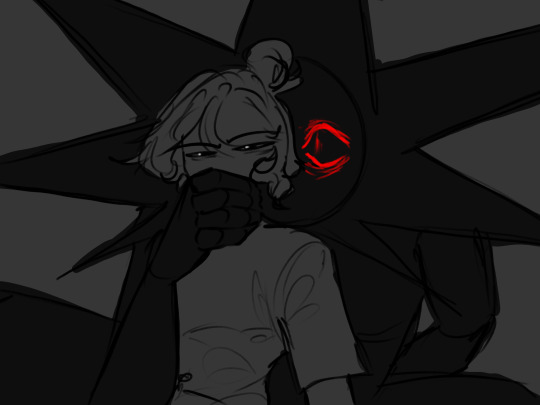
Demon paralysis
(Context: I see demons or paralysis and since I'm mostly influenced by sun and moon lately. I see them like this-
They don't look like this and honestly they look blurry)
#fnaf fandom#fnaf security breach#fnaf sb#artists on tumblr#art#doodle#fnaf au#funny#illustration#fnaf#artt#sillyposting#sleep paralysis#analysis paralysis#entity
548 notes
·
View notes